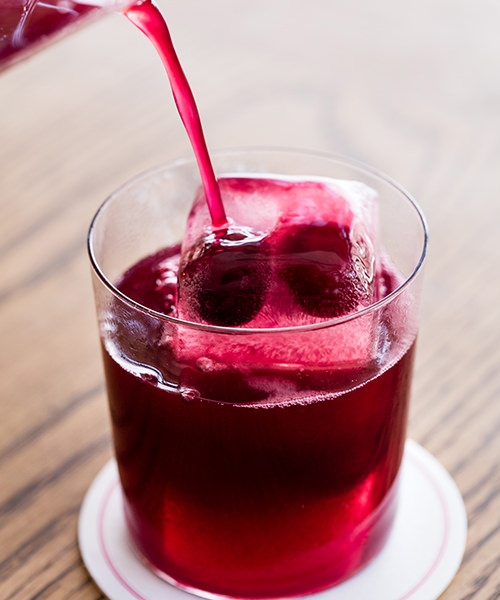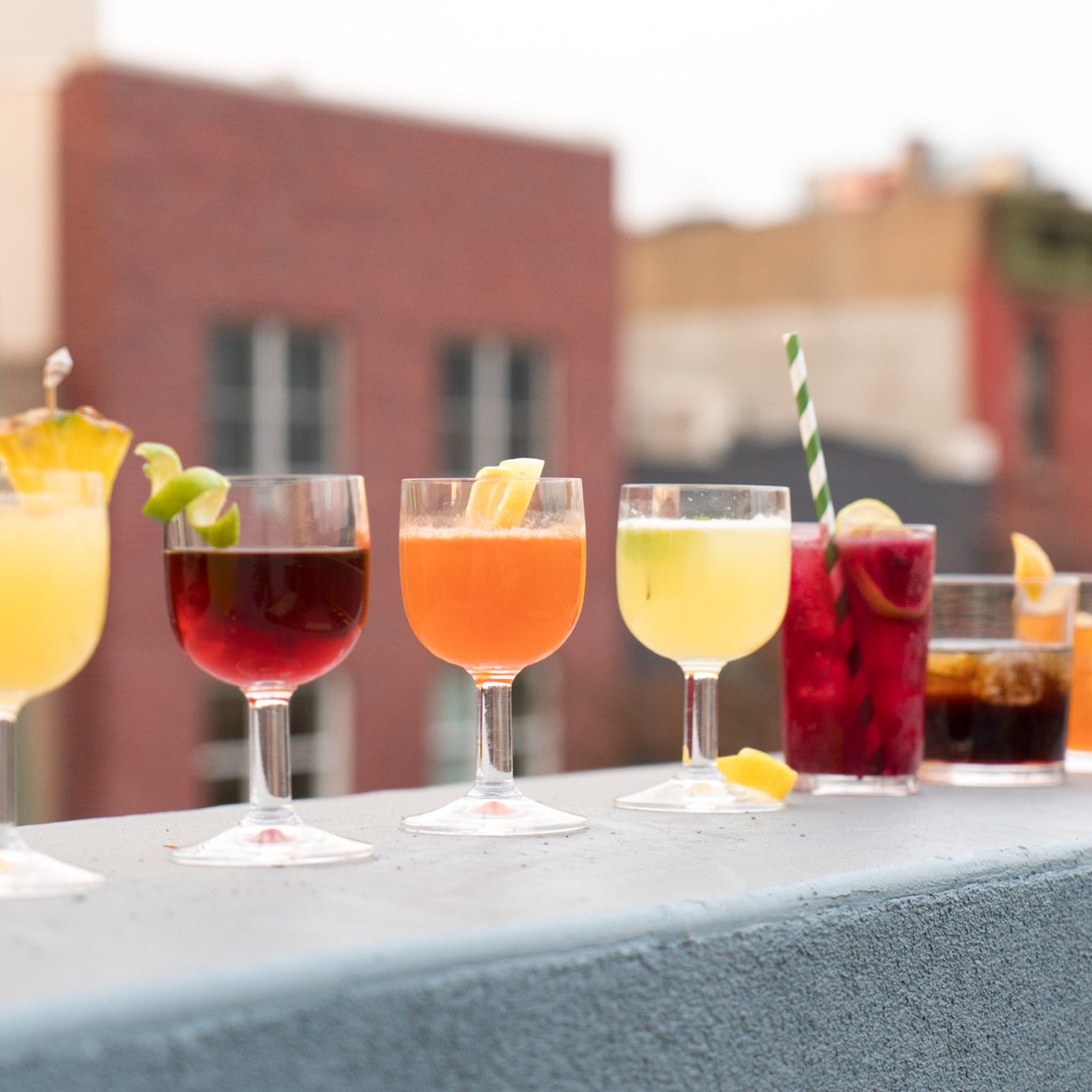Generally speaking, Jeffrey Morgenthaler is not a fan of cocktail pairings. “I only provide them when requested,” he says. Morgenthaler is bar manager of Clyde Common, a lauded restaurant and bar in Portland, Oregon.“And when I do, the most important consideration is balancing strengths, not flavors.”
Morgenthaler is not alone. Many sommeliers and chefs contend that cocktails are simply too intense for food. Once everyone is seated at tables with napkins in laps, conventional wisdom has long been that cocktail hour is over.
“Historically, people have thought of wine as the best accompaniment to food,” Joe Santos, founder of Brooklyn Gin, says, “But now you have Michelin-starred restaurants that only serve beer, and likewise people are way more interested in drinking cocktails with great food.”
Now bartenders and chefs are collaborating in inventive, unconventional ways. Restaurants offer dedicated cocktail pairings, in which customized drinks are designed to complement specific courses. A boozy Old Fashioned might get a food-friendly makeover with easy-drinking oloroso, for example; likewise, a bartender might use a specialized spirit to highlight particular flavors in a dish.
In an Epicurious article titled, “Dare to Pair Cocktails and Food,” JJ Goode wrote, “That restaurants around the country are beginning to offer food-cocktail pairings is a testament to how far cocktails have come in recent years.”
No matter what your opinions are about pairing mixed drinks with food, it is clearly not a trend. It’s part of the evolution of American cocktail culture, and it’s being thoughtfully pursued by some the biggest names in the biz.
Have It Your Way
Unlike wines, which are opened and poured and maybe decanted, cocktails offer seemingly infinite possibilities for real-time customization. Spirit type, strength, and composition can all be tweaked to better suit a meal, course, or even an individual’s preferences.
“I love the Mr. Potato Head style of cocktail-making,” Nick Bennett, head bartender of Porchlight in NYC, says. “There are plenty of variations on classic drinks that can be adapted to go with food. I like sherry-based Daiquiris because they are low-proof and allow me to continue enjoying the night.”
https://www.instagram.com/p/BYeH9XInhQc/?taken-by=porchlightbar
Balancing booze is an important component of cocktail-paired meals, but there are risks in switching up spirits just for the sake of alcohol content. “The intoxicating quality of high-proof drinks is an essential part of their identity,” warns Jim Meehan of NYC’s legendary Please Don’t Tell, “and when you start stripping that away, there is a placebo effect that can be disorienting and disingenuous.”
One way bartenders maintain the integrity of their cocktails while sustaining multi-course meals is to approach pairings from 30,000 feet. Instead of considering how an individual drink matches a particular dish, “you look at the dining experience holistically, like a trip in an airplane,” Morgenthaler says. “Take off with a good Martini and some oysters (they’re the Martinis of the sea) … Then hit a gentle cruising altitude with wine, which has more subtle flavors and usually lower alcohol than cocktails. After several hours, you’re burnt out, and to land, you return to intensity with sweet, sticky desserts and a neat spirit with a lot of alcohol to seal the deal.”
The diversity of spirits available today helps bartenders craft creative, sustainable pairings. The wide varieties of mezcal, rhum agricole, eau de vie, and others give bartenders increased options to work with, according to Will Schragis, national director of Barrell Bourbon. “These un-aged distillates offer a much greater array of pairing options, and the beauty of using these spirits is often in their precision as opposed to their complexity, as is the case with so many brown spirits,” Schragis says.
“Old-Fashioneds, Manhattans, etc. may not innately be the best pairings for food but, given the creativity and amount of thought that modern bartenders are putting into the cocktails, there’s no reason that they shouldn’t be,” Bennett agrees.
The flip side of endless customization, of course, is the potential for gimmickry. “A lot of bartenders just think, O.K, we’re doing a carrot dish, so let’s do a carrot juice and Pisco cocktail, and I think, ‘oh, fuck no,’” Morgenthaler says.
Meehan politely refers to these as “‘stunt pairings.’ They can work and are very interesting, but sometimes are imposed on a diner, pedagogically. Generally, a guest shouldn’t have to work too hard; it should be intuitive … I don’t go to bars and restaurants to be shown how little I know about dining and drinking.”
Palate Reset
Chicago’s Alinea is better known for its cerebral, cutting-edge cuisine than its drinks — the three-Michelin-starred restaurant actually doesn’t have a bar. It does, however, work with Micah Melton, beverage director of The Aviary, to create cocktail pairings with meals.
“We treat them like a dish,” Mike Bagale, Alinea’s executive chef, says. “We try to use it almost as a pause in the menu to cleanse the palate, usually on the lower alcohol side. For instance, if we have a Thai dish and want to take some of the heat off without going for the more traditional Riesling or beer, we’ll reach for a cocktail.”
Palate cleansers are often parts of coursed menus, but they tend to be edible, not potable. While wines certainly vary from light to full-bodied, cocktails are exponentially more diverse in flavor, weight and potency. They can be thoughtfully deployed to balance both heft and flavor in long, multi-course meals.
https://www.instagram.com/p/BeYrC8EjqE0/?taken-by=thealineagroup
Schragis calls this a “palate reset,” and notes that it works both ways. “If you are serving a highly alcoholic beverage as a pairing, there needs to be a well-placed reset, such as a fatty dish to allow you to follow that drink with a different one,” he says, “In this way, you are able to plan for palate fatigue.”
Meehan agrees. “A glass of Gewürztraminer probably is not going to cleanse your palate after uni,” he says, “And I’m not saying I want whiskey with uni, but maybe I do.”
The flavors in versatile drinks like Cobblers or Daiquiris can be used to balance the tastes of that uni — or any complex menu item. “A cocktail can act like a seasoning, using herbaceous ingredients, to complement whatever story we’re trying to tell,” Bagale adds. “It’s about telling a story and making the experience a little more three-dimensional.”
Where to Try It
If you’re eager to try pairing cocktails with a meal, there are a few ways to help ensure your experience is a good one. First of all, be open to stepping outside your comfort zone. Don’t miss out on cool stuff because you think you only like vodka and tequila; allow the experts to introduce you to new things.
If you’re seated at a table rather than the bar, give as much information about your preferences and expectations to your server as possible. Schragis encourages diners to give thought to whether “the person who is answering questions, making recommendations, and suggesting pairings seems to have the information and training necessary to provide the right cocktails to accompany their choice of dishes.” If the server seems unsure or ill-equipped, either take a stab at a direct conversation with the bartender, or save the cocktail-pairing adventure for another time.
Some classic cocktail bars, such as Audrey Saunders’ Pegu Club in Manhattan, have been making food to be accompanied by tailored cocktails for years. At The NoMad Bar, also in NYC, clever bartenders with access to a superb kitchen are able to whip up drinks to accompany nearly any dish on the menu. In Brooklyn, Llama Inn makes cocktails like the Llama del Rey, made with pisco, red wine, and purple corn. Available on draft, the cocktail is simultaneously refreshing and opulent, and makes for a perfect pairing with the restaurant’s beet and gooseberry salad.

*
In nearly every creative field, innovators are simultaneously embracing and deconstructing the classics. Consider Dante in NYC, where bartenders have somehow made traditional aperitivo-style drinks like Aperol Spritzes and Garibaldis feel new, fresh, and exciting. Anybody who tells you they aren’t spectacular accompaniments to the San Daniele prosciutto and pear salad on Dante’s menu is putting you on.
It makes you wonder whether this debate was actually settled long ago, quietly, by millions of people before us drinking vodka with caviar and cured fish in Russia, or generations of sun-drenched Greeks cheerfully sipping ouzo with their mezze. Time will tell.
